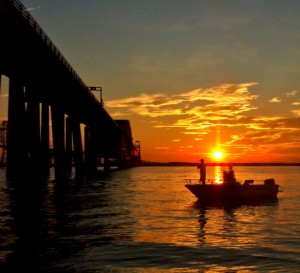bay bridge
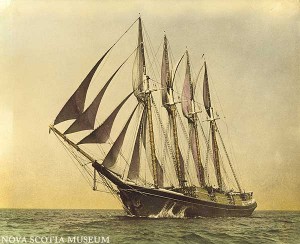 At 7:00 PM on the evening of March 15th, 1912, the four-masted schooner Herbert D. Maxwell left her anchorage near the mouth of the Magothy River and sailed southeast across the Chesapeake Bay toward Kent Island. Built in Maine and designed to haul lumber, the 186 foot cargo ship carried 1150 tons of fertilizer from Baltimore bound for Wilmington, North Carolina. At her helm was her captain and master, William Quillan accompanied by his brother Elay and first mate J.C. Scott. She carried an additional crew of six deck hands. Since winds were mostly calm, it had been slow going down the Chesapeake. After a drowsy sail to just south of Sandy Point, the wind completely died causing Captain Quillan to drop anchor once again. The crew slept until roused by a building northeast breeze at 3:00 AM. Quillan gave the order to the mate to get underway. After pulling anchor and setting sail, The Maxwell ran under clear skies before a 15-knot wind for about 40 minutes when her lookout made an ominous call, “Lights of a steamer, dead-on ahead!” Three minutes later, at 4:44 AM on March 16th, the wooden schooner was ripped apart by the 3200-ton northbound steamship S.S. Gloucester. She sank quickly carrying the first mate and three other crew members to their deaths. Read More!
At 7:00 PM on the evening of March 15th, 1912, the four-masted schooner Herbert D. Maxwell left her anchorage near the mouth of the Magothy River and sailed southeast across the Chesapeake Bay toward Kent Island. Built in Maine and designed to haul lumber, the 186 foot cargo ship carried 1150 tons of fertilizer from Baltimore bound for Wilmington, North Carolina. At her helm was her captain and master, William Quillan accompanied by his brother Elay and first mate J.C. Scott. She carried an additional crew of six deck hands. Since winds were mostly calm, it had been slow going down the Chesapeake. After a drowsy sail to just south of Sandy Point, the wind completely died causing Captain Quillan to drop anchor once again. The crew slept until roused by a building northeast breeze at 3:00 AM. Quillan gave the order to the mate to get underway. After pulling anchor and setting sail, The Maxwell ran under clear skies before a 15-knot wind for about 40 minutes when her lookout made an ominous call, “Lights of a steamer, dead-on ahead!” Three minutes later, at 4:44 AM on March 16th, the wooden schooner was ripped apart by the 3200-ton northbound steamship S.S. Gloucester. She sank quickly carrying the first mate and three other crew members to their deaths. Read More!
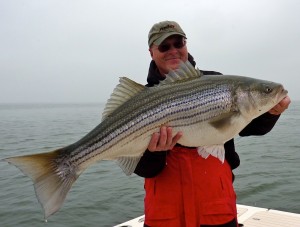 I don’t know a single fishermen who hasn’t lost the biggest fish of their life. Everyone knows the big one always gets away, right? Nevertheless, anglers are eternal optimists. Most of us aren’t out to catch another fish the same size as the last one. We expect the next one to be a lot bigger. I don’t know about you, but I’m forever certain the world record is waiting to swallow my lure on my next cast. Since the strike-outs keep us going, I guess we should plan for them. Here are eight sure-fire tips to guarantee that fish-of-a-life-time gets away. I’ve tested each one so I know they work!
I don’t know a single fishermen who hasn’t lost the biggest fish of their life. Everyone knows the big one always gets away, right? Nevertheless, anglers are eternal optimists. Most of us aren’t out to catch another fish the same size as the last one. We expect the next one to be a lot bigger. I don’t know about you, but I’m forever certain the world record is waiting to swallow my lure on my next cast. Since the strike-outs keep us going, I guess we should plan for them. Here are eight sure-fire tips to guarantee that fish-of-a-life-time gets away. I’ve tested each one so I know they work!
Tip #1 – Don’t retie after a big fish. It’s a waste of time. Just pat yourself on the back and cast again because it’s a sure bet that your next strike will be from a fish twice as big and there’s nothing more satisfying than standing on the bow with a slack line watching your world record swim off into the sunset. Read More!
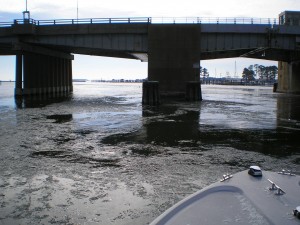 Catching striped bass in winter on the Chesapeake Bay isn’t easy. It’s not that the fish aren’t around because there are some to be caught. It’s just that it’s very hard to get to them. We’ve had an exceptionally cold December followed by multiple sub-freezing days in January. It’s also been very windy. The windows of light-tackle opportunity are frosted. Even on rare days when the weather is fishable it’s a challenge to get on the water because the boat launches around Kent Island have been iced in solid. Fortunately, we got a little warming trend this week, so a few ramps opened up. Read More!
Catching striped bass in winter on the Chesapeake Bay isn’t easy. It’s not that the fish aren’t around because there are some to be caught. It’s just that it’s very hard to get to them. We’ve had an exceptionally cold December followed by multiple sub-freezing days in January. It’s also been very windy. The windows of light-tackle opportunity are frosted. Even on rare days when the weather is fishable it’s a challenge to get on the water because the boat launches around Kent Island have been iced in solid. Fortunately, we got a little warming trend this week, so a few ramps opened up. Read More!
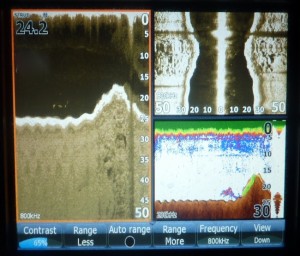 Back when I was a kid tramping through the woods of East Tennessee, I looked for the underground dens of rabbits, chipmunks and woodchucks. Now days, I’m stalking fish instead of varmints, but I’m still hunting for hidey-holes. It’s the time of year when Chesapeake Bay striped bass hunker down in deep, warm-water hideouts. It takes patience and persistence to catch them but if you aggravate them long enough, you can sometimes get them to bite. The trollers are still picking off a few big cows around the channels, but it’s tough to get isolated fish on a jig. From now until the first of the year I’ll be fishing around the bridges and in the deeper water around other submerged structure looking for holed-up rockfish. Read More!
Back when I was a kid tramping through the woods of East Tennessee, I looked for the underground dens of rabbits, chipmunks and woodchucks. Now days, I’m stalking fish instead of varmints, but I’m still hunting for hidey-holes. It’s the time of year when Chesapeake Bay striped bass hunker down in deep, warm-water hideouts. It takes patience and persistence to catch them but if you aggravate them long enough, you can sometimes get them to bite. The trollers are still picking off a few big cows around the channels, but it’s tough to get isolated fish on a jig. From now until the first of the year I’ll be fishing around the bridges and in the deeper water around other submerged structure looking for holed-up rockfish. Read More!
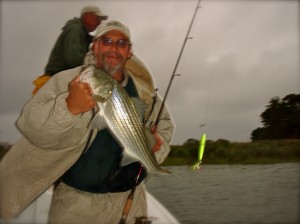 Fall is coming fast to the Chesapeake region bringing changing patterns in fish behavior. This is the time when resident Bay rockfish move shallow and start feeding heavily in order to put on winter weight. While there are still active fish in the open waters over the oyster bars and around the mid-Bay islands, the real fun is close in to the shore; so close in fact that you really don’t need a boat. A kayak or even waders are more appropriate this time of year, the only challenge being access to the best fishing spots. It’s tough to get most center console style fishing boats in tight enough to shore. Many light tackle anglers compromise by going with a bay style boat. That’s a good idea, but since I also fish the big water in the worst of the winter, I prefer a larger ride with a steeper deadrise. Due to the savvy design skills of Eastern Shore boat builder Bill Judge, I feel like I have the best of both worlds. Thunder Road, my 2010 Judge 27 CC only draws about 16 inches. I’ve put all 16 to use and then some over the past couple of weeks while working the grass beds of Talbot and Dorchester counties. Check out the video below and you’ll see what I mean. Read More!
Fall is coming fast to the Chesapeake region bringing changing patterns in fish behavior. This is the time when resident Bay rockfish move shallow and start feeding heavily in order to put on winter weight. While there are still active fish in the open waters over the oyster bars and around the mid-Bay islands, the real fun is close in to the shore; so close in fact that you really don’t need a boat. A kayak or even waders are more appropriate this time of year, the only challenge being access to the best fishing spots. It’s tough to get most center console style fishing boats in tight enough to shore. Many light tackle anglers compromise by going with a bay style boat. That’s a good idea, but since I also fish the big water in the worst of the winter, I prefer a larger ride with a steeper deadrise. Due to the savvy design skills of Eastern Shore boat builder Bill Judge, I feel like I have the best of both worlds. Thunder Road, my 2010 Judge 27 CC only draws about 16 inches. I’ve put all 16 to use and then some over the past couple of weeks while working the grass beds of Talbot and Dorchester counties. Check out the video below and you’ll see what I mean. Read More!



